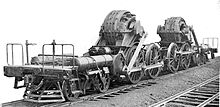Jackshaft

The jackshaft is part of the drive system for locomotives with mechanical power transmission and rod drive. It is usually mounted in the vehicle frame or in the gearbox housing at right angles to the direction of travel and transmits the torque of the gearbox to the locomotive's wheelsets using coupling rods . This form of drive was widespread in many electric and diesel locomotives until around 1940 , but is now only used for slow locomotives with low power. The jackshaft itself is usually located in the sprung part of the vehicle. The drive power is only transmitted to the unsprung drive wheel sets through articulated coupling rods.
One of the few examples of steam locomotives with a jackshaft is the Bavarian "Glaskastl" ( Bayerische PtL 2/2 ). The jackshaft located between the coupling axles should avoid a driving rod that is too long . A drive via jackshafts was also used in some steam turbine locomotives, for example in the two locomotives of the DR series T 18.10 .
In the case of the Ce 6/8 II of the SBB , the jackshaft is not used to transfer the drive force via coupling rods to the drive wheel sets, as is the case with the Ge 4/6 of the Rhaetian Railway , but as a supporting and compensating element. The triangular rod, which is attached to the countershaft , the first drive wheel set and only then to the jackshaft, directly drives the first drive wheel set. The coupling rod attached to the triangle rod then drives the second drive wheel set. The third set of wheels is driven by another coupling rod.
Individual evidence
- ↑ Fred Hofmann: Der Spalter Bockl. 1997, accessed December 21, 2013 .
- ^ Bruno Lämmli: The mechanical drives. (No longer available online.) 2010, archived from the original on November 2, 2013 ; Retrieved December 21, 2013 . Info: The archive link was inserted automatically and has not yet been checked. Please check the original and archive link according to the instructions and then remove this notice.
